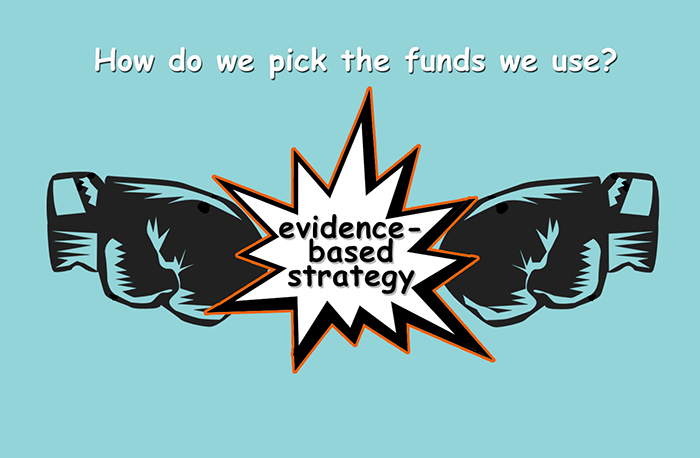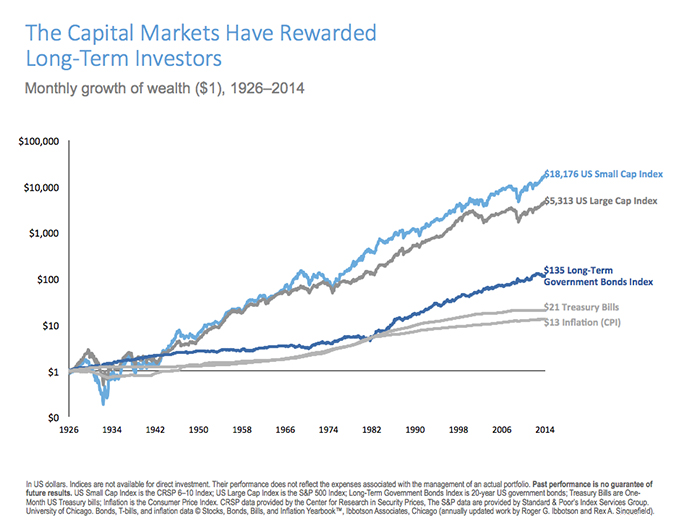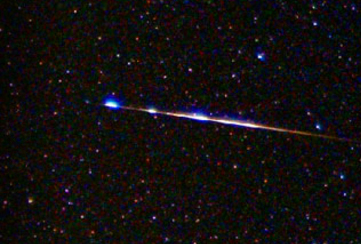
How Do We Pick the Funds We Use? (Hint: It’s Not About Star-Gazing)

“How do you pick the funds you use?” This is a frequently asked question, and a fair one.
Out of the thousands of contenders, how do we pick the right funds for you and your investment portfolio? Our selection process is a bit like a highly personalized, sudden-death tournament. We still consider the entire mutual fund universe of possibilities, but it’s relatively easy to eliminate the vast majority of them in the early rounds, with only the strongest surviving as viable candidates.
Round One: Speculative vs. Evidence-Based Strategy
In the first round, we want to eliminate fund managers who are playing an entirely different game from what we have in mind. Essentially, there are two ways investors and fund managers alike participate in the market:
- Speculative: You can try to forecast the upcoming performance of securities, sectors or markets and trade accordingly. Individuals may do this by gazing at funds’ “star” ratings or acting on seemingly hot tips from any number of sources. Fund managers may hire well-heeled analysts to probe the universe for secrets about to unfold, and issue buy, sell or hold recommendations accordingly. Either way, as we explained in this post, these are not exercises that are expected to beat the market, especially after the costs involved in trying.
- Evidence-Based: Instead, you or your fund manager can hold the universe and be part of its expected expansion, as illustrated by this simple, but powerful picture.

Speculative fund managers may be working very hard at what they’re doing, but it’s an exercise that is expected to detract from rather than benefit your goals as an investor seeking to build durable wealth in volatile markets. By eliminating them from our recommended playlist, we can readily knock out a wide swath of would-be fund selections in the opening round.
Round Two: Passive vs. Evidence-Based Strategy
Once we disqualify speculative fund managers, that still leaves a relatively large (and growing) collection of funds that seek to efficiently capture various dimensions of the market’s expected long-term growth without engaging in seemingly fruitless and costly forecasting.
In this category, you’ll find two broad types of funds:
- Index Funds: Index funds track popular benchmarks such as the S&P 500 or the Barclay’s Global Aggregate, which in turn track particular market asset classes such as U.S. large-cap value stocks or global bonds.
- Evidence-Based Funds: Evidence-based funds seek to wring the highest expected returns with the least expected risk out of similar market asset classes in a more flexible, but still rigorously disciplined manner.
The goals of each are similar, mind you, making it harder to choose among these second-round contestants. Each emphasizes the importance of minimizing wasted efforts and maximizing the factors we can expect to control.
Still, we typically favor evidence-based funds for the core of our clients’ portfolios, because we feel they are structured to do an even better job at participating in relatively efficient markets over time. By being freed from slavishly following a popular benchmark and similar restrictive rules, they can focus directly on the fund management factors that matter the most according to what the evidence has to say on the matter. This includes most effectively capturing markets’ expected returns, while aggressively managing for market risks, minimizing trading costs and dampening some of the noisy volatility along the way.
One evidence-based fund manager describes its process in this way (emphases are ours):
“[T]he day-to-day running of client portfolios is a steady, disciplined, methodical process. Huge amounts of data—on companies and securities—feed into complex and detailed systems and processes that each day balance the need to target the desired premiums with the actual cost of accessing them.
Because we generally do not closely track indices or seek to exploit perceived mispricing, we can avoid seeking immediacy in our trades. That in turn allows us to be patient and flexible in an effort to obtain more favorable prices than someone who feels compelled to trade a particular security at a particular time.”
Round Three: You AND Evidence-Based Strategy
Once we’ve narrowed down our fund choices to a manageable group, the final step is to match the best funds with the most important factor of all: you and your individual goals.
This is one of many reasons why we want you to have a personalized plan in place, preferably in the form of a written Investment Policy Statement. For example, investing heavily in even the best emerging market fund on the planet may not be a good choice for you if your greatest goal is to preserve the wealth you already have accumulated. Conversely, an excellent bond fund may be best used in moderation if you are on an aggressive campaign to accumulate more wealth.
Bottom line, our final round typically involves blending the remaining contenders into a unified team that is optimized to reflect your unique goals and risk tolerances. Then, we want you to stick with your carefully constructed team approach, not just for a game or two, but throughout the seasons of your wealth strategy.
A Solid Fund Selection Strategy
When we talk about fund selection, you may already have noticed that we deliberately emphasize the qualities that decades of empirical and practical evidence have indicated are worth pursuing over time. We explicitly downplay the more typical “play by play” reactionary antics.
Star performers – their glittery victories and agonizing defeats – may be interesting to read about and may seem important. But at the end of the day, we believe that the best investment selections – the ones that are structured to help you achieve your own hopes and dreams – are not found by wishing upon a star, but by keeping your financial footing on solid, evidence-based ground.
 Sage Serendipity: … Not that we have anything against actual stargazing! SPACE.com has listed two events the end of this month on it’s 10 Must-See Stargazing Events of 2015 list. On October 26, for the second time this year, “Venus and Jupiter will engage in a close conjunction, this time separated by just over 1 degree, Venus passing to the southwest (lower right) of Jupiter and shining more than 10 times brighter than the huge gas giant.” And also the Taurid meteor showers continue from mid October to mid November peaking on November 5 -12. 2015 is expected to be a fireball meteor producing year.
Sage Serendipity: … Not that we have anything against actual stargazing! SPACE.com has listed two events the end of this month on it’s 10 Must-See Stargazing Events of 2015 list. On October 26, for the second time this year, “Venus and Jupiter will engage in a close conjunction, this time separated by just over 1 degree, Venus passing to the southwest (lower right) of Jupiter and shining more than 10 times brighter than the huge gas giant.” And also the Taurid meteor showers continue from mid October to mid November peaking on November 5 -12. 2015 is expected to be a fireball meteor producing year.
 Secure Document Sharing
Secure Document Sharing


